Jie Bao
Enhancing Adversarial Robustness with Conformal Prediction: A Framework for Guaranteed Model Reliability
Jun 09, 2025Abstract:As deep learning models are increasingly deployed in high-risk applications, robust defenses against adversarial attacks and reliable performance guarantees become paramount. Moreover, accuracy alone does not provide sufficient assurance or reliable uncertainty estimates for these models. This study advances adversarial training by leveraging principles from Conformal Prediction. Specifically, we develop an adversarial attack method, termed OPSA (OPtimal Size Attack), designed to reduce the efficiency of conformal prediction at any significance level by maximizing model uncertainty without requiring coverage guarantees. Correspondingly, we introduce OPSA-AT (Adversarial Training), a defense strategy that integrates OPSA within a novel conformal training paradigm. Experimental evaluations demonstrate that our OPSA attack method induces greater uncertainty compared to baseline approaches for various defenses. Conversely, our OPSA-AT defensive model significantly enhances robustness not only against OPSA but also other adversarial attacks, and maintains reliable prediction. Our findings highlight the effectiveness of this integrated approach for developing trustworthy and resilient deep learning models for safety-critical domains. Our code is available at https://github.com/bjbbbb/Enhancing-Adversarial-Robustness-with-Conformal-Prediction.
Residual Reweighted Conformal Prediction for Graph Neural Networks
Jun 09, 2025Abstract:Graph Neural Networks (GNNs) excel at modeling relational data but face significant challenges in high-stakes domains due to unquantified uncertainty. Conformal prediction (CP) offers statistical coverage guarantees, but existing methods often produce overly conservative prediction intervals that fail to account for graph heteroscedasticity and structural biases. While residual reweighting CP variants address some of these limitations, they neglect graph topology, cluster-specific uncertainties, and risk data leakage by reusing training sets. To address these issues, we propose Residual Reweighted GNN (RR-GNN), a framework designed to generate minimal prediction sets with provable marginal coverage guarantees. RR-GNN introduces three major innovations to enhance prediction performance. First, it employs Graph-Structured Mondrian CP to partition nodes or edges into communities based on topological features, ensuring cluster-conditional coverage that reflects heterogeneity. Second, it uses Residual-Adaptive Nonconformity Scores by training a secondary GNN on a held-out calibration set to estimate task-specific residuals, dynamically adjusting prediction intervals according to node or edge uncertainty. Third, it adopts a Cross-Training Protocol, which alternates the optimization of the primary GNN and the residual predictor to prevent information leakage while maintaining graph dependencies. We validate RR-GNN on 15 real-world graphs across diverse tasks, including node classification, regression, and edge weight prediction. Compared to CP baselines, RR-GNN achieves improved efficiency over state-of-the-art methods, with no loss of coverage.
Structure-Aware Stylized Image Synthesis for Robust Medical Image Segmentation
Dec 05, 2024



Abstract:Accurate medical image segmentation is essential for effective diagnosis and treatment planning but is often challenged by domain shifts caused by variations in imaging devices, acquisition conditions, and patient-specific attributes. Traditional domain generalization methods typically require inclusion of parts of the test domain within the training set, which is not always feasible in clinical settings with limited diverse data. Additionally, although diffusion models have demonstrated strong capabilities in image generation and style transfer, they often fail to preserve the critical structural information necessary for precise medical analysis. To address these issues, we propose a novel medical image segmentation method that combines diffusion models and Structure-Preserving Network for structure-aware one-shot image stylization. Our approach effectively mitigates domain shifts by transforming images from various sources into a consistent style while maintaining the location, size, and shape of lesions. This ensures robust and accurate segmentation even when the target domain is absent from the training data. Experimental evaluations on colonoscopy polyp segmentation and skin lesion segmentation datasets show that our method enhances the robustness and accuracy of segmentation models, achieving superior performance metrics compared to baseline models without style transfer. This structure-aware stylization framework offers a practical solution for improving medical image segmentation across diverse domains, facilitating more reliable clinical diagnoses.
Game-Theoretic Defenses for Robust Conformal Prediction Against Adversarial Attacks in Medical Imaging
Nov 07, 2024

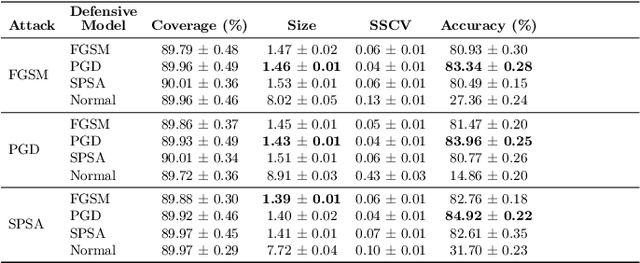

Abstract:Adversarial attacks pose significant threats to the reliability and safety of deep learning models, especially in critical domains such as medical imaging. This paper introduces a novel framework that integrates conformal prediction with game-theoretic defensive strategies to enhance model robustness against both known and unknown adversarial perturbations. We address three primary research questions: constructing valid and efficient conformal prediction sets under known attacks (RQ1), ensuring coverage under unknown attacks through conservative thresholding (RQ2), and determining optimal defensive strategies within a zero-sum game framework (RQ3). Our methodology involves training specialized defensive models against specific attack types and employing maximum and minimum classifiers to aggregate defenses effectively. Extensive experiments conducted on the MedMNIST datasets, including PathMNIST, OrganAMNIST, and TissueMNIST, demonstrate that our approach maintains high coverage guarantees while minimizing prediction set sizes. The game-theoretic analysis reveals that the optimal defensive strategy often converges to a singular robust model, outperforming uniform and simple strategies across all evaluated datasets. This work advances the state-of-the-art in uncertainty quantification and adversarial robustness, providing a reliable mechanism for deploying deep learning models in adversarial environments.
LLM-Oriented Retrieval Tuner
Mar 04, 2024



Abstract:Dense Retrieval (DR) is now considered as a promising tool to enhance the memorization capacity of Large Language Models (LLM) such as GPT3 and GPT-4 by incorporating external memories. However, due to the paradigm discrepancy between text generation of LLM and DR, it is still an open challenge to integrate the retrieval and generation tasks in a shared LLM. In this paper, we propose an efficient LLM-Oriented Retrieval Tuner, namely LMORT, which decouples DR capacity from base LLM and non-invasively coordinates the optimally aligned and uniform layers of the LLM towards a unified DR space, achieving an efficient and effective DR without tuning the LLM itself. The extensive experiments on six BEIR datasets show that our approach could achieve competitive zero-shot retrieval performance compared to a range of strong DR models while maintaining the generation ability of LLM.
Rethinking Dense Retrieval's Few-Shot Ability
Apr 12, 2023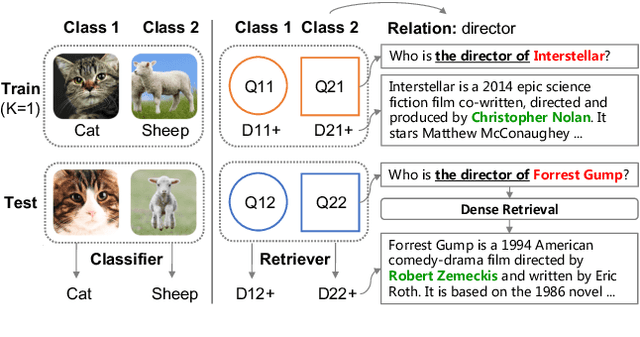


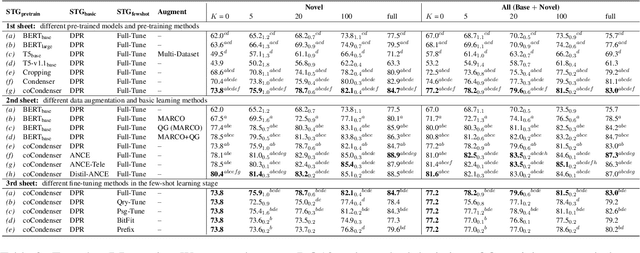
Abstract:Few-shot dense retrieval (DR) aims to effectively generalize to novel search scenarios by learning a few samples. Despite its importance, there is little study on specialized datasets and standardized evaluation protocols. As a result, current methods often resort to random sampling from supervised datasets to create "few-data" setups and employ inconsistent training strategies during evaluations, which poses a challenge in accurately comparing recent progress. In this paper, we propose a customized FewDR dataset and a unified evaluation benchmark. Specifically, FewDR employs class-wise sampling to establish a standardized "few-shot" setting with finely-defined classes, reducing variability in multiple sampling rounds. Moreover, the dataset is disjointed into base and novel classes, allowing DR models to be continuously trained on ample data from base classes and a few samples in novel classes. This benchmark eliminates the risk of novel class leakage, providing a reliable estimation of the DR model's few-shot ability. Our extensive empirical results reveal that current state-of-the-art DR models still face challenges in the standard few-shot scene. Our code and data will be open-sourced at https://github.com/OpenMatch/ANCE-Tele.
Scientific Computing Algorithms to Learn Enhanced Scalable Surrogates for Mesh Physics
Apr 01, 2023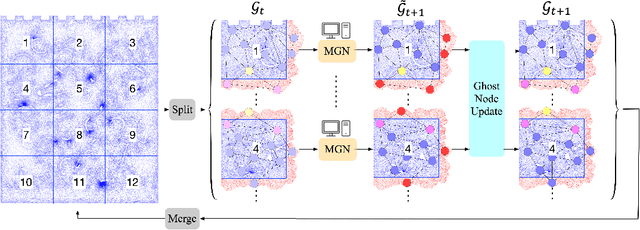



Abstract:Data-driven modeling approaches can produce fast surrogates to study large-scale physics problems. Among them, graph neural networks (GNNs) that operate on mesh-based data are desirable because they possess inductive biases that promote physical faithfulness, but hardware limitations have precluded their application to large computational domains. We show that it is \textit{possible} to train a class of GNN surrogates on 3D meshes. We scale MeshGraphNets (MGN), a subclass of GNNs for mesh-based physics modeling, via our domain decomposition approach to facilitate training that is mathematically equivalent to training on the whole domain under certain conditions. With this, we were able to train MGN on meshes with \textit{millions} of nodes to generate computational fluid dynamics (CFD) simulations. Furthermore, we show how to enhance MGN via higher-order numerical integration, which can reduce MGN's error and training time. We validated our methods on an accompanying dataset of 3D $\text{CO}_2$-capture CFD simulations on a 3.1M-node mesh. This work presents a practical path to scaling MGN for real-world applications.
Reduce Catastrophic Forgetting of Dense Retrieval Training with Teleportation Negatives
Oct 31, 2022



Abstract:In this paper, we investigate the instability in the standard dense retrieval training, which iterates between model training and hard negative selection using the being-trained model. We show the catastrophic forgetting phenomena behind the training instability, where models learn and forget different negative groups during training iterations. We then propose ANCE-Tele, which accumulates momentum negatives from past iterations and approximates future iterations using lookahead negatives, as "teleportations" along the time axis to smooth the learning process. On web search and OpenQA, ANCE-Tele outperforms previous state-of-the-art systems of similar size, eliminates the dependency on sparse retrieval negatives, and is competitive among systems using significantly more (50x) parameters. Our analysis demonstrates that teleportation negatives reduce catastrophic forgetting and improve convergence speed for dense retrieval training. Our code is available at https://github.com/OpenMatch/ANCE-Tele.
Latent Space Simulation for Carbon Capture Design Optimization
Dec 22, 2021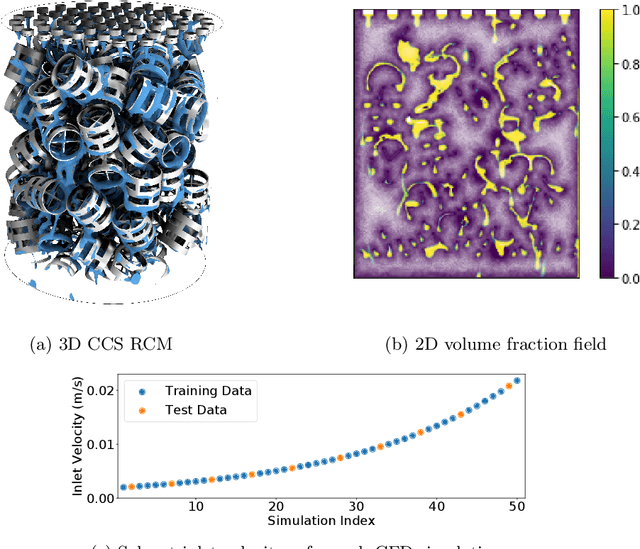



Abstract:The CO2 capture efficiency in solvent-based carbon capture systems (CCSs) critically depends on the gas-solvent interfacial area (IA), making maximization of IA a foundational challenge in CCS design. While the IA associated with a particular CCS design can be estimated via a computational fluid dynamics (CFD) simulation, using CFD to derive the IAs associated with numerous CCS designs is prohibitively costly. Fortunately, previous works such as Deep Fluids (DF) (Kim et al., 2019) show that large simulation speedups are achievable by replacing CFD simulators with neural network (NN) surrogates that faithfully mimic the CFD simulation process. This raises the possibility of a fast, accurate replacement for a CFD simulator and therefore efficient approximation of the IAs required by CCS design optimization. Thus, here, we build on the DF approach to develop surrogates that can successfully be applied to our complex carbon-capture CFD simulations. Our optimized DF-style surrogates produce large speedups (4000x) while obtaining IA relative errors as low as 4% on unseen CCS configurations that lie within the range of training configurations. This hints at the promise of NN surrogates for our CCS design optimization problem. Nonetheless, DF has inherent limitations with respect to CCS design (e.g., limited transferability of trained models to new CCS packings). We conclude with ideas to address these challenges.
Crowd-sensing Enhanced Parking Patrol using Sharing Bikes' Trajectories
Oct 29, 2021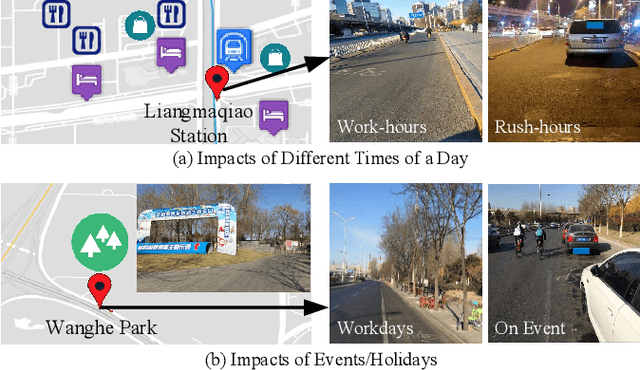
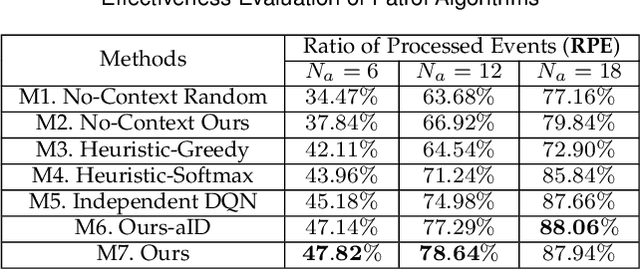
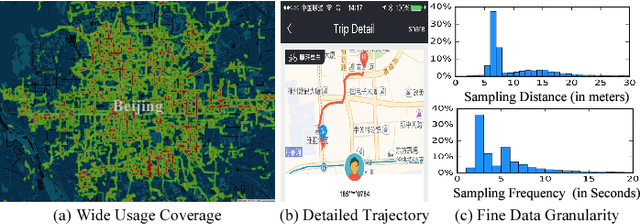

Abstract:Illegal vehicle parking is a common urban problem faced by major cities in the world, as it incurs traffic jams, which lead to air pollution and traffic accidents. The government highly relies on active human efforts to detect illegal parking events. However, such an approach is extremely ineffective to cover a large city since the police have to patrol over the entire city roads. The massive and high-quality sharing bike trajectories from Mobike offer us a unique opportunity to design a ubiquitous illegal parking detection approach, as most of the illegal parking events happen at curbsides and have significant impact on the bike users. The detection result can guide the patrol schedule, i.e. send the patrol policemen to the region with higher illegal parking risks, and further improve the patrol efficiency. Inspired by this idea, three main components are employed in the proposed framework: 1)~{\em trajectory pre-processing}, which filters outlier GPS points, performs map-matching, and builds trajectory indexes; 2)~{\em illegal parking detection}, which models the normal trajectories, extracts features from the evaluation trajectories, and utilizes a distribution test-based method to discover the illegal parking events; and 3)~{\em patrol scheduling}, which leverages the detection result as reference context, and models the scheduling task as a multi-agent reinforcement learning problem to guide the patrol police. Finally, extensive experiments are presented to validate the effectiveness of illegal parking detection, as well as the improvement of patrol efficiency.
 Add to Chrome
Add to Chrome Add to Firefox
Add to Firefox Add to Edge
Add to Edge